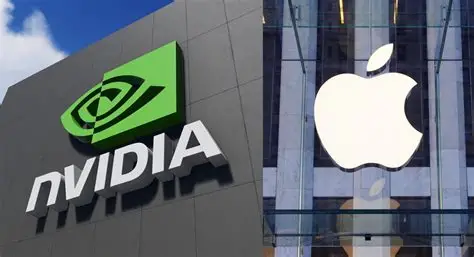Technology
- by:
- Nick H
Key Points
The technology sector covers software, hardware, semiconductors, internet platforms, and emerging tech
Core growth drivers include innovation, digital transformation, scale, and global expansion
Leading companies such as Apple, Microsoft, and Nvidia dominate global tech markets
Best Tech Stocks To Buy Today
For adsense add
Advertisement

affiliate add
For adsense add
Mail Sign Up
Get The Latest News & Stock Picks
Stay ahead of the market with expert news, actionable tips, and exclusive stock picks delivered straight to your inbox. Join a community of investors who value real insights and smarter strategies. Sign up now and get the edge you need to invest with confidence.
By submitting your email, you agree to receive updates and promotional content from our team. You can unsubscribe at any time. For more details, please review our Privacy Policy.
For adsense add
For adsense add
The technology sector has transformed the global economy, revolutionizing how people communicate, work, shop, learn, and entertain themselves. From the smartphones in our pockets to the cloud platforms powering businesses, technology touches nearly every aspect of modern life. For investors, the sector offers not only dynamic growth but also a front-row seat to continuous innovation and disruption.

As one of the largest and most influential sectors in the stock market, technology is a major engine for wealth creation and productivity. Understanding its structure, drivers, and challenges is essential for anyone looking to build a forward-thinking, resilient portfolio.
What Is the Technology Sector?
The technology sector comprises companies that research, develop, manufacture, and distribute technology products and services. This broad industry spans everything from hardware and software to internet platforms and semiconductors.
Main Segments of the Technology Sector
1. Software and Services
This category includes companies developing operating systems, enterprise software, cloud computing, cybersecurity, and IT consulting services. These firms help businesses operate more efficiently and securely.
2. Hardware and Equipment
Companies here manufacture physical technology products such as computers, smartphones, networking devices, and storage equipment. Hardware enables the digital infrastructure used by individuals and businesses worldwide.
3. Semiconductors
Semiconductor companies design and produce chips and processors that are the “brains” of electronic devices. From personal electronics to cars and industrial equipment, semiconductors are foundational to modern technology.
4. Internet and Digital Platforms
These include search engines, social media networks, e-commerce sites, and streaming services. Digital platforms have become key to advertising, retail, entertainment, and social interaction.
5. Emerging Technologies
This segment covers artificial intelligence, robotics, virtual reality, blockchain, quantum computing, and more. These innovations are pushing the boundaries of what technology can achieve.
How Investors Access the Technology Sector
There are several ways for investors to gain exposure:
Individual Stocks:
Technology giants and fast-growing disruptors are widely traded on major exchanges, offering choices for every risk appetite.
Technology Sector ETFs and Mutual Funds:
Funds provide diversified exposure to leading tech companies across multiple industries and regions.
Thematic Funds:
Some ETFs and funds focus on trends like artificial intelligence, cybersecurity, or cloud computing, targeting high-growth niches.
What Drives the Technology Sector?
Several powerful forces underpin the tech sector’s rapid evolution and investment appeal:
1. Innovation and Research & Development
Continuous investment in research and development fuels new products, services, and business models. Companies that innovate faster often secure market leadership and premium valuations.
2. Digital Transformation
Businesses and consumers are embracing digital solutions—from cloud computing to online shopping—creating constant demand for new technologies. The global shift to remote work and digital infrastructure is accelerating tech adoption.
3. Scale and Network Effects
Successful technology companies benefit from scale and network effects, where increased users drive more value and higher margins. Platform-based businesses can dominate their markets.
4. Globalization and Market Expansion
Technology transcends borders. Leading tech firms serve global markets, unlocking vast revenue streams and diversifying risks.
5. Data and Connectivity
The explosive growth of data and the rise of connected devices (Internet of Things) are opening new frontiers for analytics, automation, and smart products.
Leading Companies in the Technology Sector
The sector is home to some of the world’s most valuable and innovative firms:
Apple (AAPL): Leader in consumer electronics, software, and digital services.
Microsoft (MSFT): Dominant in enterprise software, cloud computing, and productivity tools.
Alphabet (GOOGL): Parent of Google, the global leader in online search, digital advertising, and cloud.
Nvidia (NVDA): Pioneer in graphics processing units (GPUs), AI, and high-performance computing.
Amazon (AMZN): E-commerce and cloud computing giant, driving retail and technology innovation.
Meta Platforms (META): Social media and virtual reality leader, owner of Facebook, Instagram, and WhatsApp.
Risks and Challenges in Technology Investing
Despite its growth and dynamism, the technology sector faces several notable risks:
1. Rapid Obsolescence:
Product lifecycles are short. Companies must innovate constantly to stay relevant and ahead of competitors.
2. Competition and Disruption:
Tech is fiercely competitive. Disruptors can quickly erode market share, and even industry leaders face new challengers.
3. Regulatory Pressure:
Antitrust scrutiny, privacy laws, and cybersecurity regulations are rising, particularly for the largest global tech firms.
4. Valuation Volatility:
Tech stocks can experience sharp price swings due to market sentiment, earnings surprises, or macroeconomic shifts.
5. Supply Chain Risks:
Semiconductor shortages, trade disputes, and geopolitical tensions can disrupt hardware production and distribution.

Technology Sector Outlook: Trends and Forecasts
Several key trends are shaping the technology sector’s future:
Artificial Intelligence and Automation:
AI is transforming industries from healthcare to finance. Companies that harness AI for automation, analytics, and product innovation will lead future growth.
Cloud Computing and Edge Computing:
Cloud services continue to expand, enabling remote work, data storage, and software delivery. Edge computing is growing as data processing moves closer to end-users and devices.
Cybersecurity:
As digital threats increase, demand for robust cybersecurity solutions is soaring, making it a fast-growing tech segment.
5G and Next-Gen Connectivity:
Rollout of 5G networks is enabling faster mobile connections, supporting new applications like smart cities, autonomous vehicles, and augmented reality.
Sustainability and Green Tech:
Technology firms are investing in energy efficiency, renewable energy, and solutions to support climate action, creating new opportunities for investors.

How to Evaluate Technology Stocks
When analyzing tech companies, focus on:
Innovation and Product Pipeline: Does the company have a history of successful product launches and R&D leadership?
Revenue Growth and Profit Margins: Strong, consistent growth with scalable business models is a positive sign.
Market Position and Network Effects: Market leaders with large user bases and strong ecosystems often sustain profitability.
Balance Sheet Strength: Healthy cash flow and minimal debt enable continued investment and resilience.
Global Reach and Diversification: Companies with broad, international operations are less vulnerable to regional disruptions.
Technology as a Cornerstone of Modern Portfolios
The technology sector offers investors exposure to some of the world’s most innovative, high-growth companies. It stands at the forefront of digital transformation, shaping the future of every major industry. While the sector brings unique risks, its potential rewards make it a critical part of diversified portfolios. By focusing on market leaders, innovation, and the forces driving digital change, investors can capitalize on technology’s unmatched impact.
For adsense add






